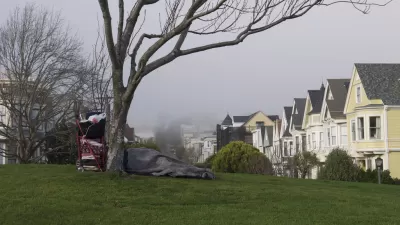One of the sad contradictions of the revival of core urban areas has been the clash between waves of investment and affluence with large populations of homelessness. Many cities are still coming to terms with the issue, much less solving it.

"As once derelict or sleepy downtown districts in U.S. cities evolve into thriving hot spots, officials are grappling with what to do about homeless populations that have long inhabited them," according to an article by Arian Campo-Flores, Cameron McWhirter and Alejandro Lazo.
The article also notes that thought he number of homeless people around the country is declining overall, several cities, including New York, Los Angeles, San Francisco, Miami, and Seattle, the number is increasingly. "In New York, the homeless population increased nearly 42% to 75,323 from 53,187," for instance.
As planners know, redevelopment exacerbates the homelessness issue in more ways that one: "While city officials, who often support redevelopment, face added pressure from new residents to address homelessness, advocates for the unsheltered say the response too often is to try to remove them from sight without providing adequate support."
Besides those most famous of U.S. cities listed above, the article also spends some time in Tulsa, where downtown revitalization has meant that the city's homeless population is "no longer out of site out of mind."
FULL STORY: Thriving U.S. Cities Grapple With Homelessness Surge

Pennsylvania Mall Conversion Bill Passes House
If passed, the bill would promote the adaptive reuse of defunct commercial buildings.

Planning for Accessibility: Proximity is More Important than Mobility
Accessibility-based planning minimizes the distance that people must travel to reach desired services and activities. Measured this way, increased density can provide more total benefits than increased speeds.

World's Largest Wildlife Overpass In the Works in Los Angeles County
Caltrans will soon close half of the 101 Freeway in order to continue construction of the Wallis Annenberg Wildlife Crossing near Agoura Hills in Los Angeles County.

New York Passes Housing Package Focused on New Development and Adaptive Reuse
The FY 2025 budget includes a new tax incentive, funding for affordable housing on state land, and support for adaptive reuse and ADUs.

LA Metro Board Approves New 710 Freeway Plan
The newest plan for the 710 corridor claims it will not displace any residents.

Austin’s Proposed EV Charging Rules Regulate Station Locations, Size
City planners say the new rules would ensure an efficient distribution of charging infrastructure across the city and prevent an overconcentration in residential areas.
City of Costa Mesa
Licking County
Barrett Planning Group LLC
HUD's Office of Policy Development and Research
Mpact Transit + Community
HUD's Office of Policy Development and Research
Tufts University, Department of Urban and Environmental Policy & Planning
City of Universal City TX
ULI Northwest Arkansas
Urban Design for Planners 1: Software Tools
This six-course series explores essential urban design concepts using open source software and equips planners with the tools they need to participate fully in the urban design process.
Planning for Universal Design
Learn the tools for implementing Universal Design in planning regulations.


























